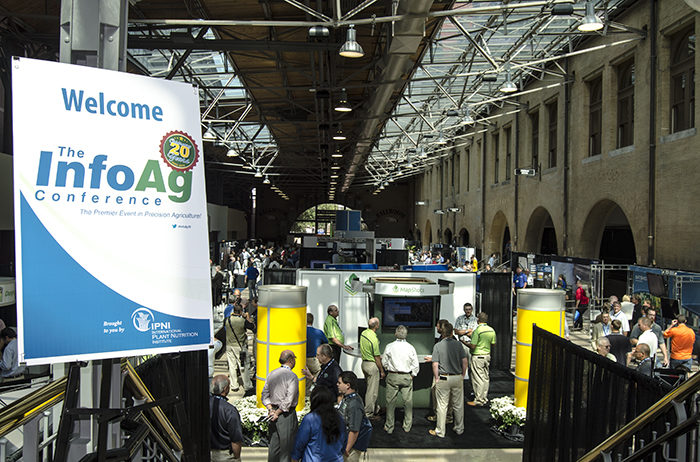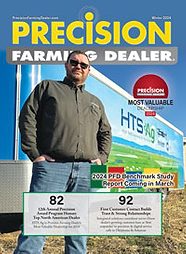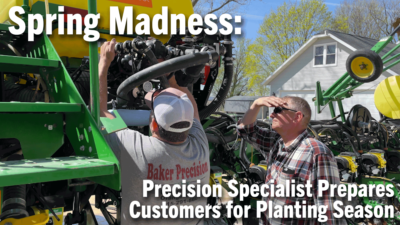The InfoAg Conference in St. Louis, Mo., celebrated its 20th anniversary this year in late July by having another record-breaking turnout. At over 1,500 registrants, 80 presenters and 64 hours of program content, it’s the biggest InfoAg yet. Billed as the premier event in precision agriculture, InfoAg’s back-to-back banner years highlight the industry’s growing importance despite a commodity slump.
Precision Farming Dealer editors were on the look out for the top takeaways from InfoAg for specialists to consider. Here are four of the most talked about tidbits from the conference.
Concerns About Data
It could be said that the talk of the conference was data — its storage, transfer and utilization. However, in farmer Larkin Martin’s presentation on precision technologies that have worked on her family’s farm, she expressed trepidation.
Martin touched on the default concerns over ownership and security, but she went further to discuss conflicts of interest and efficacy. Among her worries are that input providers are working themselves into advisory roles with the help of data, and that data aggregated from a broad base of growers doesn’t seem applicable to local circumstances.
In a conference hall showcasing the very latest ag data platforms for collection, storage, distribution and analysis, Martin asked how much of the data in the rapidly growing pool is reliable.
“We should ask ourselves about the relevance of aggregated data,” says Martin. “I know I have a lot of junk data and good data on our farm, not everything I capture is equally valuable. If 50% of mine is junk, then I assume other folks have some junk data too. I’d hate to see our data logged into the same sources that are going to be used to advise us and others on their farming practices.”
Ag Tech on the Horizon
In a presentation by Marc Vanacht of AG Business Consultants on what’s coming for precision Ag in the next 20 years, he covered many the usual suspects — UAVs, autonomous field equipment and crop sensing. He says that precision equipment will continue to head in the direction of gathering increasingly detailed field information and storing it, but it appears that a blind spot exists in translating that data into real time information.
“For the farmer to get real value from their data, they’ll want to know how their corn is doing today, not how they did at harvest in September — it’s too late to do anything then,” says Vanacht.
He speculates that a dashboard type display that offers real time, farm-wide, actionable information pulled from multiple pieces of equipment is a device that will figure heavily into the future of precision ag.
“We want to know how green the corn is right now, which fields have trouble or where is it too wet,” he says. “We want to know where to intervene. This can be done through a real-time status dashboard, that can provide information that will immediately trigger action rather than just data for future considerations.”
UAVs: Eyes in the Sky
No precision farming conference would be complete without a lengthy discussion about UAVs. A stroll through the exhibition hall quickly showcased the advancing technology in functionality, weight and battery life, but a focus this year seemed to be more on the cameras attached to the UAVs than the UAVs themselves. Depending on which exhibitor is asked, camera resolution and the technology used to stitch photos together are still limiting factors for UAVs on the farm.
Dr. Kevin Price of AgPixel, LLC discussed turning images taken with UAVs and low-altitude aircraft into decision support in his presentation. Price notes that the higher the resolution, the more valuable the data is likely to be.
“When you fly a good camera you can almost count tillers on winter wheat from 400 feet up,” says Price “For that, we’ll fly a bigger wide plane with some carrying capacity, because we want high quality images. During weed scouting, you can see individual weeds and their patterns. If they have a scattered distribution, it’s likely they are wind-blown annuals. If they’re clumped, they’re likely perennial and rhizomatous. But you can see it, and that will change what chemical you’ll use on them.”
Safeguarding Data
Amid the flood of ag gadgets that collect farm data and platforms built for storing and transferring it at InfoAg, the question of its security become part of the landscape. Three presenters from the law firm Husch Blackwell addressed emerging legal issues that will impact precision ag businesses, and big data ownership and security was chief among them. Attorney Joan Archer feels that many service providers concern themselves too much with the immediate implications of data ownership rather than examining the wider scope — something that can be handled fairly easily with proper contract language.
“If you want to make sure that you and your customers’ data is protected, it has to be protected through the whole chain,” says Archer. “You need to look at the landowner or lessee of the land being farmed. You need to look at the equipment manufacturer, the crop consultants and the precision ag providers. It seems overwhelming, but if you spend the time to think about it, it’s not. It’s a question of having the specific language in your contracts.”








Post a comment
Report Abusive Comment